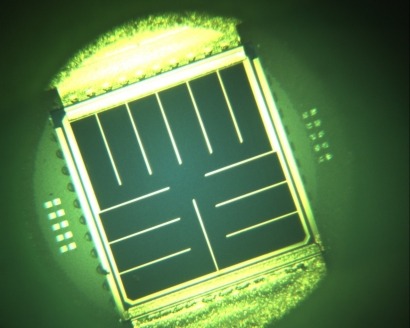
Hypersolar, the developer of a new technology aimed at producing renewable hydrogen using sunlight and water (see our 28th March story), has announced that the technology is now capable of producing 1.1 volt open circuit voltage for use in direct solar hydrogen production. The advance represents a 10 percent increase over the 1.0 volt reached 3 months ago.
The theoretical voltage for splitting water into hydrogen and oxygen is 1.23 volts, and approximately 1.5 volts in real world systems. However, achieving 1.5 volts using inexpensive solar cells has so eluded researchers all over the world. Silicon cells are the most inexpensive and abundant, but their 0.7 volt open circuit voltage is not enough to split water and commercially available high voltage solar cells are considered to be far too expensive for use in hydrogen production.
“Our cutting-edge research program at the University of California Santa Barbara, led by Dr. Syed Mubeen Hussaini, continues to make impressive progress” said Tim Young, CEO of HyperSolar. “The 1.1 volt milestone is very exciting in that it provides us with a clear and encouraging roadmap to reach the 1.5 volts needed for water splitting. The semi-conductor materials used are very inexpensive, which gives us confidence that a low cost system is possible. The process to make this novel solar cell is equally exciting in that it is a simple solutions-based chemistry process. It does not require conventional expensive semiconductor processes and facilities and was literally made in a beaker.”
Mr Young added that there will soon be increased demand for clean hydrogen with the recent announcement of Hyundai, Honda, Toyota and other major auto manufacturers to begin shipping hydrogen fuel cell cars next year.
“We believe our technology can address two serious drawbacks impeding major adoption of hydrogen automobiles” he said. “First, the lack of hydrogen production infrastructure near the point of distribution or the fueling stations is addressed by our solar hydrogen production process. Second, hydrogen is currently produced from a fossil fuel—natural gas—in a process that releases substantial amounts of carbon dioxide into the atmosphere.”
HyperSolar’s research is directed at developing a low-cost and submersible hydrogen production particle that can split water molecules under the sun, emulating the core functions of photosynthesis. Each particle will be a complete hydrogen generator that contains a novel high voltage solar cell bonded to chemical catalysts by a proprietary encapsulation coating.
For additional information:

